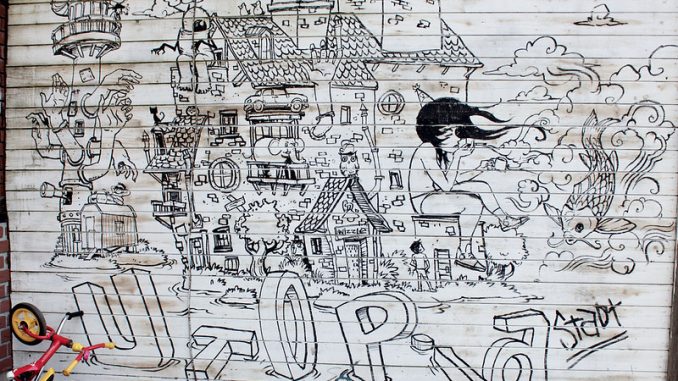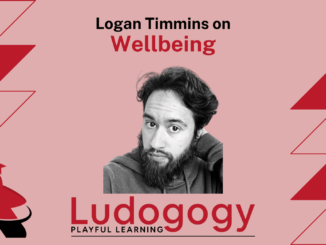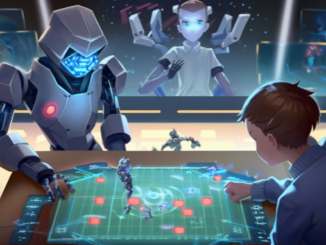
In perhaps the most highbrow mother-in-law joke ever, it is said that John Milton started work on ‘Paradise Lost’ (1667) when his wife’s mother moved in with him, and on ‘Paradise Regained’ (1671) shortly after she moved out.(1) The first poem, as is obvious from the title deals with the loss of Paradise, due to Original Sin. Eden, the very first Utopia was destroyed by our own very human failings.
What’s in a word?
Writers and other creatives have had a fascination with both ideally good and ideally bad places for as long as human creativity has existed. The archetypes of ‘Heaven’ and ‘Hell’ exist in many religions and philosophies, and those two locations have been joined by many man-made utopias and dystopias down the years.
Plato’s ‘Republic’ (c. 375 BC) is often cited as being the first Utopian novel, although of course, the truth is much complex than that. It does however contain a description of an imaginary city, the Kallipolis, so it is as well to include in this review. When viewed as a description of a ‘ideal’ city, The Republic has attracted much criticism due to the totalitarian nature of the government of Kallipolis.

Nowhere is a Utopia
The first person to write about a ‘Utopia’ was Sir Thomas More. It is, rather satisfyingly, a pun, based on a Greek word meaning ‘Nowhere’, but which sounded like a similar Greek word meaning ‘Good Place’ (And if there was ever a utopia that suddenly revealed itself to be exactly the opposite, ‘The Good Place’ (2016 – 2020) is most definitely it). His ‘Utopia’ (1516), described a perfect island state, and contrasted it with the ‘real’ world of crime, poverty and discord. Aspects of More’s Utopia include communal property, which each person can draw upon according to their need, a welfare state and free hospitals, and extreme religious tolerance. However premarital sex is punishable by a lifetime of enforced celibacy, and slavery is a prominent feature of the society, which should remind us forcibly and importantly, that one person’s Utopia is another’s Dystopia.
Imaginary Worlds
Dystopias (at least in terms of the word itself) came along some centuries later. John Stuart Mill, inspired by More’s work, added the Latin prefix ‘dys’, meaning ‘bad’ to the front of utopia, to create the idea of a perfect world gone bad. He first used the word in 1868, while criticising the British government’s Irish Land policy.
The ‘Nowhere’ meaning was adopted in both Utopian and Dystopian writing which followed. William Morris wrote ‘News from Nowhere’ (1890), which described a state of perfect socialism. The protagonist of this work of speculative fiction falls asleep after attending a meeting of the Socialist League and wakes in a perfect agrarian future where people take pleasure in both nature and in their work. In ‘Erewhon’ (1872) (Nowhere, nearly, spelt backwards), by Samuel Butler, a society which at first seems Utopian is revealed to be far from it. In this satire of Victorian England, disease is seen as a crime and the sick are imprisoned, whereas criminality is seen as a sickness and criminals are hospitalised.

Social Dystopias
This foreshadowing of the demonisation and criminalisation of gay men (and other queer people), largely because of HIV/AIDS, in the 1980’s, culminating in the abhorrent Section 28, is something that later readers could certainly take from this text, as well as the racist attacks on Asian Americans in the wake of the COVID-19 pandemic. Also, eerily prescient of today’s concerns, machines have been outlawed, as being dangerous competitors of humans in the race for survival.
Although not all Utopian or Dystopian stories are set in fictional futures, even those that are not, are often discovered to contain more or less accurate predictions of things to come, some time after they are written. Because these works are by nature speculative the authors are often conjecturing what may come next, based on what they already see in front of them.
Technological Utopias
Two authors who can definitely been seen as promoting the idea of a technology-driven future Utopia, are H.G.Wells and Jules Verne. Indeed, Wells called himself a ‘utopiographer’ and firmly believed that scientific and technological advancement would necessarily lead to a better future. His novels and stories including often describe futures where technology has taken much of the misery and labour out of human life. In ‘A Modern Utopia’ (1905), Wells attempts to explain the difference between the ‘static’ utopias that had gone before (where an ideal state had been reached and human happiness only required that that state be maintained) and his vision of a ‘kinetic’ utopia where a benevolent ruling class of ‘samurai’ would enable progress alongside political stability.
Verne, whose future visions have foreshadowed so many of the inventions we take for granted today, wrote of one we could certainly wish we had today. In the ‘Begum’s Fortune’ (1879), he writes about houses constructed out of a material which allows optimum air flow and which are heated by stoves, topped by an apparatus which scrubs the smoke completely clean of carbon particles before discharging the cleaned air into the atmosphere.
Through a glass darkly
Once Utopias and Dystopias were able to leap off the page and onto the big (and small) screen, we entered a new golden age of speculative creativity – a Utopia for fans of imaginary worlds, and much has been written about whether the mood of a particular age or decade can be gauged by whether its films are largely optimistic or pessimistic.

Political dystopias abound in the early 20th century, and many of these made their way onto cellulose. George Orwell’s allegory about the Russian Revolution of 1917, and the subsequent Stalinist era, Animal Farm (1945), was re-imagined as an animated film in 1954 and as a live action movie in 1999. Both versions sanitised the book somewhat, and the book itself has been the subject of several bans in the US, Russia, China and the UAE down the years.
Dystopias in Film
Orwell’s other most famous dystopic work, ‘Nineteen Eighty-Four’ (1949), foreshadows the hyper-surveilled world that many of us now live in, along with a totalitarian state. John Hurt took the part of Winston Smith in the film. But for most people in the country of Orwell’s birth, the Phrase ‘Big Brother’ now brings to mind a houseful of vacuous self-publicists, willing to sacrifice every last shred of dignity in order to become ‘celebrities’…
…An idea which in itself is dealt with, in ‘Dead Set’ (2008), a five episode miniseries by Black Mirror (2011 – ) writer, Charlie Brooker, in which zombies invade the Big Brother house. Black Mirror itself is named for the black screen of our most constant companion, the mobile phone, and takes the diametrically opposite view of technology as that taken by Verne and Wells, focusing almost entirely on the unintended (and undesirable) consequences of our use and increasing reliance on technology.
A Mirror of our Hopes and Fears
Dystopias and Utopias are truly mirrors, of our most urgent concerns at any given time. The feminist dystopia,‘The Handmaid’s Tale’ (1985) grew out the rise of the religious right in the US in the 1980s, under a Reagan administration. Margaret Atwood’s mentee, Naomi Alderman wrote ‘The Power’ (2016) as the result of her attending a religiously orthodox primary school where each morning the boys would give thanks to God for not having been born women.

Concerns about overpopulation, and the prospect of feeding an ever growing population, in a world irrevocably damaged by climate catastrophe, led to ‘Soylent Green’ (1973), where the elderly and poor are encouraged to accept euthanasia, and are then made into the titular foodstuff, which feeds those who remain. Loosely based on Harry Harrison’s ‘Make Room, Make Room’ (1966), the film is set in 2022.
Human rights under a number of dystopian regimes and circumstance provide a rich seam of inspiration, particularly those which many of us now take for granted such as the right to have children. For dystopias with a focus on the regulation of fertility and genetic ‘fitness’, see ‘Gattaca’ (1997), ‘Brave New World’ (1932) and ‘The Wanting Seed’ (1962) by Anthony Burgess.
Like Animal Farm, many books / films make use of other species, alien or terrestrial, or artificial lifeforms to ask big questions about what it is to be human, and about many of the indignities and outrages we visit on other members of our species. Spielberg’s ‘AI’ (2001), Garland’s ‘Ex Machina’ (2014), Asimov’s ‘I Robot’ (1950) and many others ask us about the criteria for personhood and present dystopias where humans have gained yet another class of being which they can treat less well than they should.
What Fiver and Hazel taught us
Rabbits might seem unlikely candidates to teach us about where we are going wrong, but ‘Watership Down’ (1972) remains one of the most harrowing dystopian visions of human impacts on the natural world. More recently, Jasper Fforde’s ‘The Constant Rabbit’ (2020) presents a fictional United Kingdom where an ‘Anthropomorphic Event’ has resulted in a species of sentient human-sized rabbits (and some other animals). In a vision that could quite obviously ‘never happen here’ (ahem) the government have implemented systemic anti-rabbit policies and mis-information about their inherent criminality and their intent to ‘take over’ (aided by their superior fertility and propensity to breed like.. well.. you know..) abound. The human protagonist (secretly) holds liberal views towards rabbits, but still holds down a job in the anti-rabbit state apparatus.

So, are all the most notable stories dystopian? Well, maybe. But even dystopias can give us hope. With my love of books, ‘Farenheit 451’ (1953) is one of the worst possible dystopias I can imagine, but the ending strikes such a note of hope, that even in the worst possible situations, that if people are prepared to do what is necessary – in this case, learn a book by heart, and ‘become’ the living embodiment of that book – better times will prevail.
Optimistic Literature
But the news is not all bleak. There is now a whole literary genre (and wider cultural and practical movement) dedicated to speculative futures where humanity has already done ‘what is necessary’. Solarpunk is environmentally-focused and optimistic, showing us what may be to come, if only we get together and get our act together. Notable examples include ‘Nausicaa of the Valley of the Wind’ (1985), a manga, and later, brilliant anime from the Ghilbli stable, by Hayao Miyazaki and ‘Ecotopia’ (1975) by Ernest Callenbach. For recent anthologies see ‘Glass and Gardens: Solarpunk Summers’ (2018) and ‘Sunvault’ (2017).
Dystopian and Utopian play
Dystopian games are often adaptations of literature and films, sometimes directly, such as ‘1984:Animal Farm’ (2012), a board game which draws upon both of Orwell’s works, but more often by drawing on well-known themes. If you like the Noir-ish flavour of ‘Blade Runner’ (1982) then try ‘Android’ (2008) and its many subsequent incarnations and expansions.
If ‘Death Race 2000’ (1975) or the ‘Mad Max’ (1979 – 2015) franchise get your motor running then you could enjoy unboxing ‘Car Wars’ (1981) or ‘Road Kill Rally’ (2010).
‘Junta!’ (1978) and ‘Guillotine’ (1998) give us a glimpse into historical dystopias. And no (even brief) look at dystopian games would be complete without a mention of ‘Euphoria: Build a Better Dystopia’ (2013), a worker placement game where you must build (and maintain) the perfect golden city you have built amid a post-apocalyptic wasteland – but at the expense of individual freedoms and all knowledge of the past.
If you want a game where dystopia is your win state, you could do worse than picking up Gloom (2005), which thanks to its many imaginative expansions you can also play in space or in fairyland, among many other settings.

A search for ‘Dystopian games’ on Google returns far more than ‘Utopian games’ (much like the books and films), but there are a few notable examples.
‘Utopia Engine’ (2010) is a free print and play dice game where you attempt to avert Doomsday by constructing artifacts.
‘Utopoly’ (2017) is hack of Monopoly (1933), billed both as a game and ‘a tool for utopian practice’ it draws on Robert Jungk’s Future Workshop methodology.
There is even a game called ‘Thomas More’s Utopia’ (2018) in which players cooperate (of course) to maintain a perfect society measured on four parameters; population, happiness, culture and faith. This game is also interesting in that it has different board areas (which rotate among the players) which all have different game mechanics.
Natural World Utopias
It is noticeable that many games which could be described as utopian, do not include human protagonists at all (which should tell us something). Everdell (2018) is a beautiful game where forest animals live in harmony with their surroundings and build thriving cultures. Ecosystem (2019), Photosynthesis (2017) and Wingspan (2019) are also games where the optimum conditions for surviving and thriving are the focus of the game, but where humans do not feature.
(1) There is absolutely no evidence that the Milton/Mother-in-Law thing is true, as far as I can see, but if you want to be misogynistic and simultaneously boast a classical education, it’s a definite step-up from ‘Take my mother-in-law. Please.’
- James Bore – The Ransomeware Game - 13th February 2024
- Ipsodeckso – Risky Business - 23rd January 2024
- Review – Luma World Games - 15th December 2023





Be the first to comment